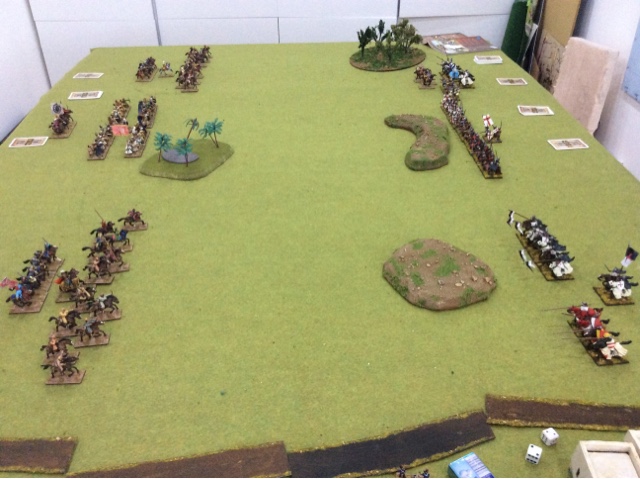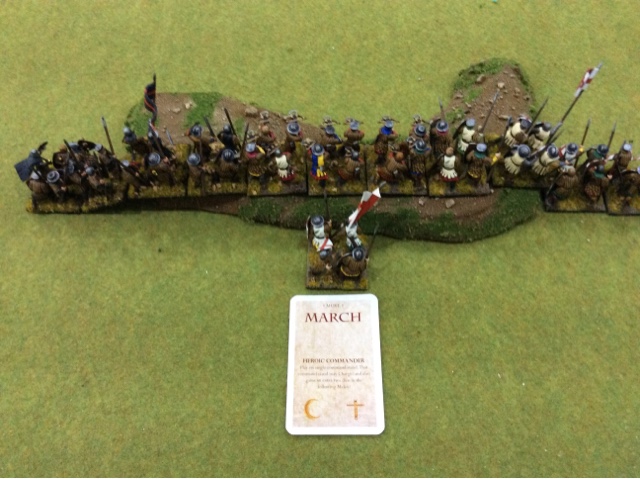So in this post I will do a little write up on my thoughts on the rules.
I found that noting down every detail (as in part one) was a brilliant way to learn the rules. As I was sharing my game on the blog I felt the need to be precise so I checked each action. I think I got just about everything right. Playing Solo isn't the same as having a real opponent but it does let you take your time.
The Book
The rules are clearly laid out with lots of examples. There is a sample game in which several moves are worked through.
The author has a couple of page spreads on his blog.
The Cards
There is a 52 card deck. Each card has an Action and a special event. The cards drive the game.
The Rules
I like card activation systems (I a'int been shot Mum style) but have not enjoyed all of the games with card mechanisms that I have played. This one worked for me. The cards add a good feeling of friction and provide challenging decision making. They don't take over. I have tried games where managing the deck takes over from moving the toys around; this game wasn't like that.The special events are fun and relevant; providing surprises even in a Solo game.
The movement rules are straight forward, as are shooting and combat with no major surprises.
I really like the Army Morale system. You start with a number derived from the units in your army. This number goes down as your army gets into contact and starts taking losses. Some events can make the number go up (a baggage camp is a good idea as it can potentially increase the Army Morale Value each turn - but don't lose it!). The reason that I like this is that it gives an indication of the health of your army and when it hits zero the game is over, no quibbling, just over and you have lost. Some rules that I play have nothing to indicate the game is over - last man standing; I don't like those. I also get frustrated with rules where a division has a break point (half of its units, broken for example) and the army breaks when a certain number of divisions break. I often feel that one more move would have turned the game around in those systems; especially when up to half of the army may not even be committed. This whole army morale mechanism feels better to me. More chance of one battle fighting a last stand whilst the other flank sweeps to victory.
The siege rules look workable. I am told sieges can be boring; these don't look boring. This could be because they concentrate on the final assault. I have no city walls or castles in my collection; maybe I will get some soon.
The scenarios are Large battle, small battle, raid and siege assault. The battles are typical line em up and fight. Raid puts one small army in the centre strip of the width of the table and the other around the short edges. I am going to try this for my first game with an opponent.
The campaign is a simple ladder system. Starts with raids, culminates in large battles and siege assaults.
Army Lists
Two army lists in the book - Saracens and Crusaders. There are force limitation for the different scenarios. For example you can't take elite "Al-Halqa" units on a raid. Lots of unit choice and nice extras like holy relics and Naffatun.
Other Thought
I like the period specificity of the rules, more flavour than using generic rules like DBx or Hail Caesar.The battle plan system is brilliant. I will be stealing it. You take three cards that define a battle plan, one for each "battle" in the army. These cards drive a default action for each "battle". So you have to make a plan and stick to it. For pre-napoleonic warfare I think that this reflects reality. Once a plan was made the commander effectively lost control and could only influence local situations. The extra cards cover the extraordinary situations (the unit commander that turns a flank and wins the day sort of stuff). But, you are stuck with the plan you select at the beginning of the game.
I think the system is expandable. A couple of ideas come to mind.
A brilliant commander could change a battle plan card once during the game, or have a one time use spare card.
It could be used for Napoleonics and after where new battle plan cards could be couriered to a Corps/Division. Rules for interpretation could take the Corps commander's personality into account and delay the change of order or even lead to it being ignored.
The rules could be used pretty much unchanged (apart from wording on some of the cards) for any medieval battle. With some suitable treachery cards maybe for Wars of the Roses (I have lots of figures, still looking for a good set of rules).
Overall
Great set of period specific rules. I really enjoyed my solo game. I have lots of figures for this era and I want a set of goto rules. Hopefully my human opponents will like them and they can become my default set.
Postscript
I did finish the game. The Crusaders destroyed the Saracen right wing in turn 5. But the Saracens killed one of the Crusader commanders on the same turn. In the final reckoning the Saracens were on an army morale of two, the crusaders hit zero. Very close run.
As a further postscript, I have played Crusades using four or five rulesets now over around 8 or 9 games. All of the games have been close but the Saracens have always won.

















